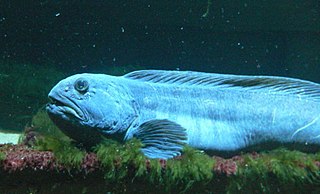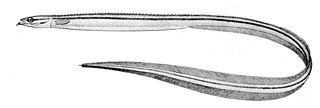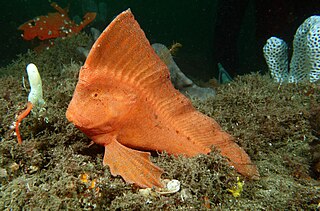
Ronquils is a small family marine ray-finned fish, the Bathymasteridae. These fishes are found only in Arctic and North Pacific waters. This family contains just seven species in three genera. The larger species are important to commercial fisheries as food fish. Ronquils are most closely related to the eelpouts and prowfish in the suborder Zoarcoidei of the order Scorpaeniformes.

Anoplopomatidae, the sablefishes, are a small family of ray-finned fishes classified within the order Scorpaeniformes. This family is the only family in the monotypic superfamily Anoplopomatoidea. These fishes are found in the North Pacific Ocean.

Hexagrammidae, the greenlings, is a family of marine ray-finned fishes belonging to the suborder Cottoidei in the order Scorpaeniformes. These fishes are found in the North Pacific Ocean.

Congiopodidae, commonly known as pigfishes, horsefishes and racehorses, is a family of ray-finned fish classified with in the order Scorpaeniformes. These fishes are native to the Southern Hemisphere.

Anarhichadidae, the wolffishes, sea wolves or wolf eels, is a family of marine ray finned fishes belonging to the order Scorpaeniformes. These are predatory, eel shaped fishes which are native to the cold waters of the Arctic, North Pacific and North Atlantic Oceans.

Pholidae is a family of marine ray-finned fishes, known as gunnels, in the scorpaeniform suborder Zoarcoidei. These are fishes of the littoral zone and are mainly found in North Pacific Ocean, with two species found in the North Atlantic Ocean and Arctic Ocean.

Stichaeidae, the pricklebacks or shannies, are a family of marine ray-finned fishes in the suborder Zoarcoidei of the order Scorpaeniformes. Most species are found in the North Pacific Ocean with a few in the North Atlantic Ocean.

The quillfish,, is a species of marine ray-finned fish, it is the only species in the genus Ptilichthys and family Ptilichthyidae. This fish occurs in the northern North Pacific Ocean.

The Australian prowfishes are a small family, the Pataecidae, of ray-finned fishes classified within the order Scorpaeniformes. Australian prowfishes are distinguished by a long dorsal fin that begins far forward on the head, forming a "prow" shape, and extends all the way to the caudal fin. They lack scales and pelvic fins.

Little velvetfishes or simply velvetfishes are a family, the Aploactinidae, of marine ray-finned fishes classified within the order Scorpaeniformes. They are small fish that have skin with a velvet texture. They live on the sea bottom close to the shore, at depths of up to 100 metres (330 ft). They are found in the Indo-Pacific region.

The Trichodontidae, or sandfishes, are a small family of ray-finned fishes from the order Scorpaeniformes. The species in this family are found in the North Pacific Ocean.

Cryptacanthodes is a genus of marine ray-finned fishes belonging to the monogeneric family Cryptacanthodidae, commonly referred to as wrymouths. Three of the four species are found in the Pacific Ocean with one species native to the western Atlantic Ocean where they are benthic fishes, tunneling through soft substrates. It is currently the only known genus in its family.

Paraploactis is a genus of marine ray-finned fish, velvetfishes belonging to the family Aploactinidae. The genus is found the Indo-Pacific.

Congiopodus is a genus of marine ray-finned fishes belonging to the family Congiopodidae, the pigfishes or horsefishes. These fishes are found in the southern Atlantic and Pacific oceans.

Hoplichthys, the ghost flatheads, is a genus of marine ray-finned fishes native to the Indian and Pacific Oceans. This genus is the only member of the family Hoplichthyidae.

The warty prowfish, also known as the smooth prowfish or Tasmanian prowfish, is a species of marine ray-finned fish, an Australian prowfish belonging to the family Pataecidae, It is endemic to the coastal waters of southern Australia where it inhabits mostly rocky reefs. This species is the only member of the monotypic genus Aetapcus.

The whiskered prowfish is a species of marine ray-finned fish, an Australian prowfish belonging to the family Pataecidae. It is endemic to the coastal waters of southern Australia. This species is the only member of the monotypic genus Neopataecus.

The Red Indian fish, also known as the red forehead fish, is a species of marine ray-finned fish, an Australian prowfish belonging to the family Pataecidae. It is endemic to the coastal waters of western and southern Australia where it occurs at depths of from 40 to 80 metres. This species is the only known member of its genus.
The stippled gunnel is a species of marine ray-finned fish belonging to the family Pholidae, the gunnels. It is the only species in the monospecific genus Rhodymenichthys. It is found in the northern North Pacific Ocean.

Opisthocentrinae is a subfamily of marine ray-finned fishes, classified within the family Stichaeidae, the pricklebacks or shannies. These fishes are found in the North Pacific Ocean.

















